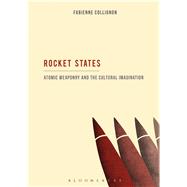Rocket States: Atomic Weaponry and the Cultural Imagination
, by Collignon, Fabienne- ISBN: 9781501317651 | 1501317652
- Cover: Paperback
- Copyright: 1/28/2016
Rocket States crosses the disciplines of Cold War Studies, American Literature, American Studies and Cultural Studies. The particular attraction of this study lies in the combination of its range-close textual and visual analysis of the correlations between land and weaponry, set firmly within its political and cultural contexts-with its unique analytical approach. The book offers a synthesis between history, theories of technology, theories of space, popular culture, literary study and military science. It illuminates a variety of literary texts from key writers and thinkers such as Pynchon, Stephen King, Norman Mailer, and Tom Wolfe, while also invoking figures like Nikola Tesla, James Webb, Batman and Ronald Reagan. Organised topographically, according to how missile technology manifests itself differently in particular locations, Rocket States's geographical targets are Colorado, Kansas, Cape Canaveral and New York, variously titled 'Excavation', 'Preservation', 'Evacuation' and 'Transmission'. It advances through these states roughly chronologically, beginning in the late 1940s and early 1950s and coming to an end in the first part of the 21st century.
Collignon's argument is concerned with identifying the recurring figures and fantasies of the Cold War: the dome or parabola as sheltering techno-form; the fictions of total security adapting to constantly changing targeting strategies; gadget love; closed, freezing worlds. As such, Rocket States analyses by what processes the Cold War is frequently literalised in its weapons installations and how these facilities, in turn, shape dreams of containment, survival, escape and techno-supremacy.






